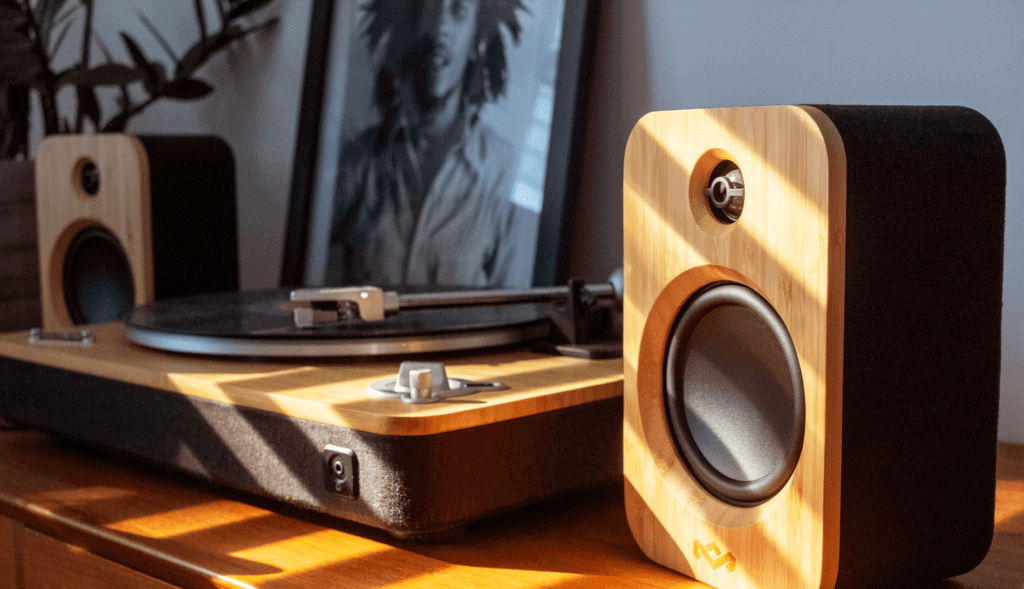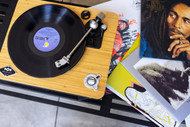Are Portable Record Players Worth It?
Posted by House of Marley on Oct 7th 2021
For all of its positives—its sonic warmth, deep sound, and attractive album covers—there's one arena where vinyl doesn't win over its streaming competitors. It isn't portable. That's where portable record players come into play. On the surface, it seems like a good idea. But is it too good to be true? Although portable record players are convenient, the all-in-one design comes with major weaknesses to be aware of.
In this article, you’ll learn everything you need to know about portable record players to help you decide if it’s the right choice for you.
What is a Portable Record Player?
Portable record players are specifically designed to be moved from one location to another, like from a dorm room to the quad or from a shelf in your apartment to the backyard for a cookout. They have all the basic mechanical functions of a traditional record player, but many of the features focus on portability and convenience over quality and durability.
Types of Portable Record Players
Before we dig into the advantages and disadvantages of portable record players, here’s an overview of the different styles.
Miniature Record Players ($50 to $100)
Have you ever received an awkward gift from a distant relative with no practical uses? Miniature record players fall under that category. They’re novelty items with speakers that are literally the size of a quarter that only play 3-inch or 7-inch records, which are much harder to find. If you primarily collect LPs, a miniature record player would be useless to you.
Suitcase Record Players ($50 to $150)
Suitcase record players are the most common grab-and-go way to listen to vinyl records. You can find them in many major retailers. In terms of design, suitcase models are just record players built into an enclosure that resembles a small suitcase. They’re built with small handles, which are typically made from plastic or artificial leather.
The main appeal of suitcase record players are the built-in speakers. Alternatively, you can connect external speakers if your record player has RCA outputs. Unfortunately, the major selling point of suitcase record players happens to be the biggest drawback. Having a record player with a built-in audio system seems appealing, but it isn’t optimized for sound quality (we’ll get into that soon).
Portable DJ Turntables ($150 to $250)
Portable DJ turntables are used for performing and music production, but they're a decent option for casual listening, too. These typically feature a stripped-down design made from hard plastic with a platter, cartridge and tonearm. High-end models have pitch sliders for adjusting the speed of the music in small increments. Portable DJ turntables don’t have built-in speakers, which means you’ll need to bring your own, making them less portable.
Connectivity Options
Here are the connectivity options that you’ll typically find in portable record players. Be aware—not all portable record players have each of these features.
RCA Outputs
RCA outputs are the standard red and white speaker outputs you’ll find on most record players, portable and not-as-portable. You can connect these to any speakers, including our Get Together Duo speakers, which are Bluetooth compatible and also have wired RCA outputs.
Bluetooth
As Bluetooth devices soar in popularity, record player manufacturers are integrating wireless technology, too. Having a Bluetooth record player gives you the flexibility to connect to other devices, like our Get Together Mini Portable Speakers and Bluetooth headphones. Some record players have a switchable built-in preamp that must be turned on to support playback through Bluetooth speakers.
Headphone Output
Some portable record players come with a 3.5 millimeter headphone output for listening through your favorite wired headphones, earbuds or any other device that takes an aux cable.
Auxiliary Input
In addition to various outputs, some portable record players give you the ability to connect media players via an auxiliary input. With a 3.5mm aux cord, you can use the onboard speakers to listen to music on mediums other than vinyl through its built-in speakers.
Advantages of Portable Record Players
Choosing a portable record player has its perks. Below we take a deeper look into what makes them popular among music lovers.
Portability
They’re called portable record players for an obvious reason—you can take them anywhere. The compact size also makes storage easy. You can fit a portable record player on a bookshelf, under a bed or in a closet without taking up a lot of space.
Affordability
Portable record players are a common choice for new record collectors because you can find them for under $100. But remember, you get what you pay for. Portable record players are affordable because they're built with cheap parts, and an inferior build quality means you won't have the best listening experience.
Built-in Speakers
Having built-in speakers sounds pretty cool at first. You don’t have to invest in an external set of speakers or worry about buying a preamp. Despite the convenience, built-in speakers are a disadvantage in disguise—more on that in a bit.
The Disadvantages of Portable Record Players
Although there are some advantages on the surface, portable record players aren’t for all music lovers. Here are some of the biggest drawbacks you should know about.
Low Sound Fidelity
Portable records players won’t produce the analog warmth you’re looking for. The audio system isn’t optimized for sound fidelity. The small speakers built into portable record players aren’t capable of reproducing frequencies evenly across the sonic spectrum. Plus, built-in speakers cause vibrations that can make your record skip, and the sound from the speakers can get picked up by the stylus, resulting in even worse audio.
Also, none of the components are upgradable. For instance, if one of the built-in speakers begins to distort, you either have to fix it, find replacement parts, or replace the entire record player.
Pairing a traditional record player with a hi-fi audio system will provide better sound fidelity. Best of all, a standard home setup will give you the flexibility to upgrade your system whenever you want.
Poor Cartridges and Styli
The cartridge and stylus are the two most important parts of a record player because they send sound from your records to the sound system. The audio conversion process happens within the cartridge, which means the efficiency of the cartridge directly affects sound quality. Portable record players use generic cartridges that are mass-produced and poorly designed. Your records aren’t toys. Why would you use a record player built like one?
When you invest in a record player, you need to choose one with a diamond-tipped stylus that is rated for at least 1,000 hours of listening time, like the ones included on our Stir It Up turntables.
Cheap Construction
Manufacturers use generic components to keep costs low. Unfortunately, combining a series of bad parts leads to performance issues. Portable record players aren’t known for lasting very long, partly because there’s a lack of attention during the design process. Some brands are focused on hip aesthetics rather than performance. When record player manufacturers ignore critical performance standards, music fans are the ones who pay the price.
A wobbly plastic platter is the most common problem that portable record players have. Without a level platter, you might experience some pretty noticeable playback issues. Instead, high-end models like Stir It Up turntables are built with aluminum platters for stable performance.
Limited Adjustability
Portable record players are ready out of the box, but this presents a major issue—you can’t adjust anything. For example, if the stylus is tracking through the groove at the wrong angle, you’ll notice distortion as the record plays. Normally, the cartridge would need to be realigned using the headshell screws, but very few portable record players give you the option.
Destructive to Vinyl Records
Do portable record players ruin vinyl records? The answer is, yes. Portable record players degrade the quality of vinyl records at a much faster rate than traditional record players. It’s caused by the short lifespan of the stylus, which typically lasts under 100 hours. Manufacturers of portable record players rarely publish this information. As a result, music lovers listen to records longer than the stylus can handle, never realizing the negative impact until permanent groove wear sets in.
Groove wear is hard to spot, but you’ll recognize it by the distorted sound as the stylus traces a certain part of the groove. In severe cases, groove wear becomes visible to the naked eye. Sadly, there isn’t any way to fix or ease the effects of groove wear. Once the damage is done, it’s there forever.
Battery Life
Not all power sources are created equal. In addition to AC power adapters, some portable record players can be powered with rechargeable batteries. The battery life can last up to 4 hours, but this isn’t the case for every model. Listening to both sides of a vinyl record can take up to 40 minutes, which only allows you to listen to six LPs before the battery dies. Streaming audio via Bluetooth may also drain the battery even faster.
A Better Way to Listen
Portable record players have some decent advantages, but the plastic components and poor sound fidelity aren’t ideal. You don’t need one to enjoy the freedom to move around. Our Stir It Up Wireless turntable connects to any Bluetooth speaker and offers a built-in switch pre-amp allowing seamless compatibility with your in-home receivers or The House of Marley Bluetooth speakers.
With premium features and superior audio quality, you can enjoy every detail of your favorite albums anywhere in your home or even in your backyard without needing a portable record player.














